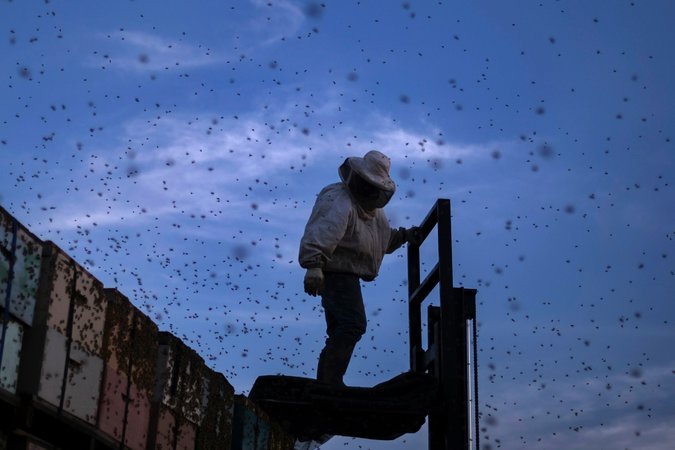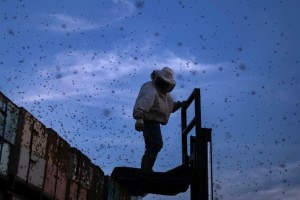
Pesticides Linked to Honeybee Deaths Pose More Risks, European Group Says
PARIS — An influential European scientific body said on Wednesday that a group of pesticides believed to contribute to mass deaths of honeybees is probably more damaging to ecosystems than previously thought and questioned whether the substances had a place in sustainable agriculture.

A beekeeper stacking his hives on a truck after the bees pollinated a blueberry field in Maine. Credit Adrees Latif/Reuters
The finding could have repercussions on both sides of the Atlantic for the companies that produce the chemicals, which are known as neonicotinoids because of their chemical similarity to nicotine. Global sales of the chemicals reach into the billions of dollars.
The European Commission in 2013 banned the use of three neonicotinoids — clothianidin, imidacloprid and thiamethoxam — on flowering plants after a separate body, the European Food Safety Authority, found that exposure to the chemicals created “high acute risks” to bees.
But the chemicals continue to be employed on an industrial scale in the United States. The Environmental Protection Agency is reviewing their use after President Obama last year established a national Pollinator Health Task Force to help address concerns about so-called colony collapse disorder, a not fully understood phenomenon that has devastated commercial apiaries.
Pesticides are thought to be only one part of the widespread deaths of bees, however. Other factors are believed to include varroa destructor mites, viruses, fungi and poor nutrition.
Two of the main producers of neonicotinoids — Syngenta, a Swiss biochemical company, and the German company Bayer CropScience — have sued the European Commission in an effort to overturn the ban, saying it is not supported by the science. That legal case is still pending.
Research has been directed largely at the effects of neonicotinoids on honeybees, but that focus “has distorted the debate,” according to the report released on Wednesday by the European Academies Science Advisory Council.
The council is an independent body composed of representatives from the national science academies of European Union member states. The European ban is up for review this year, and the council’s report, based on the examination of more than 100 peer-reviewed papers that were published since the food safety agency’s finding, was prepared to provide officials with recommendations on how to proceed.
A growing body of evidence shows that the widespread use of the pesticides “has severe effects on a range of organisms that provide ecosystem services like pollination and natural pest control, as well as on biodiversity,” the report’s authors said.
Predatory insects like parasitic wasps and ladybugs provide billions of dollars’ worth of insect control, they noted, and organisms like earthworms contribute billions more through improved soil productivity. All are harmed by the pesticides.
The report found that many farmers have adopted a preventive approach to insect control, soaking their seeds in the pesticides, a method that releases most of the chemicals directly into the environment. They said a farming approach known as integrated pest management, which takes a more natural approach to insect control, would allow for a sharp decrease in their use.
The authors were critical of studies of neonicotinoids on bee health that tested the insects’ ability to survive a single exposure to a given quantity of pesticide dust; they noted that the effect of the chemicals is cumulative and irreversible, meaning that repeated sublethal doses will eventually be deadly if a certain threshold is passed.
Considering the broad impact of the pesticides, they said, “the question is raised as to what extent widespread use of the neonicotinoids is compatible with the objectives of sustainable agriculture.”
Utz Klages, a spokesman for Bayer CropScience, said on Wednesday that the company stood by its position that its neonicotinoid products “can be used safely if they’re used according to the label.”
A European industry group to which Bayer CropScience and Sygenta belong sought on Wednesday to rebut the study, describing it as a “biased report.”
“This is not new research or even a meaningful review of all the studies available,” Jean-Charles Bocquet, director general of the European Crop Protection Association, said in a statement. “Rather, it is a misleading and very selective reading of some of the literature, especially from organizations well known for their opposition to neonicotinoids.”
The restrictive approach used by European regulators contrasts with the more lenient stance of United States regulators. In March, American opponents of neonicotinoid use delivered more than four million signatures to the White House calling for stronger action to protect pollinators.
The E.P.A. last week warned pesticide makers that it was unlikely to approve new uses for the class of pesticides “until new bee data have been submitted and pollinator risk assessments are complete.”
But critics say the E.P.A.’s interim policy is rife with loopholes, allowing continued use of existing products for approved applications, for example. They also criticized the agency for not halting the approval of some products that are chemically quite similar to neonicotinoids but classified differently for regulatory purposes.
A temporary ban on new uses “is going to have a negligible impact,” said Larissa Walker, director of a bee-protection campaign at the Center for Food Safety, an environmental advocacy group in Washington. “They really need to look at the bigger picture. They should prohibit all future registrations for all systemic pesticides.”
Pollination — the transfer of pollen from one flower to another, typically by wind, bug or bird — is essential to the global food supply. An estimated 75 percent of all traded crops, including apples, soybeans and corn, depend on pollination.
Neonicotinoids are absorbed by a plant so that the neurotoxic poison spreads throughout its tissues, including the sap, nectar and pollen. Far more deadly to insects than to mammals, they do not discriminate between harmful pests and beneficial pollinators.
But the pesticides are also among the most effective insecticides available to farmers. Proponents argue that they are essential to food security, and note that many of the chemicals they replaced were worse in important respects.
By DAVID JOLLY APRIL 8, 2015
A version of this article appears in print on April 9, 2015, on page B3 of the New York edition with the headline: Pesticides Linked to Bee Deaths Pose More Risks, European Group Says.

Sorry, the comment form is closed at this time.